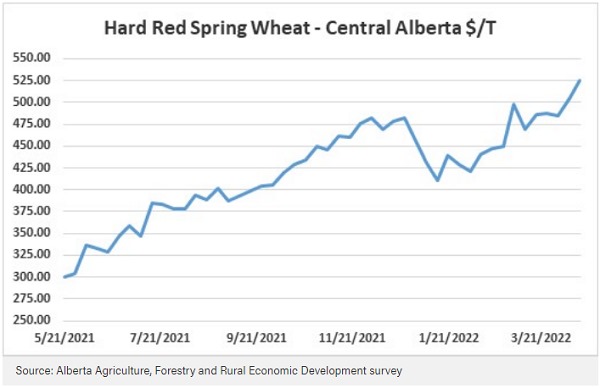Marketing alternatives for producers who are concerned with signing a deferred delivery contract.
“Wheat prices, although relatively late to begin their rally, rose from last fall, and were boosted further after Russia’s invasion of Ukraine caused Black Sea crop exports to drop,” says Neil Blue, provincial crops market analyst with Alberta Agriculture, Forestry and Rural Economic Development. “Also, dryness in U.S. hard red winter wheat regions continues to reduce prospects of that crop.”
Figure 1. Hard Red Spring Cash Prices – Central Alberta

“With wheat prices for both old and new crop historically strong, producers are interested in taking advantage of those potentially profitable prices. The decision is simple for remaining wheat in storage. Upon confirmation of the grade characteristics, it is just a matter of shopping for the best farm-gate price and metering wheat into the market via contracts.”
The decision is more difficult for new crop pricing. Large areas of the prairies remain dry and many soils have little reserve moisture following last year’s drought. Many producers were in the unfortunate position of having 2021 crop production below their contracted crop volumes, and were forced to buy out part of their contracts at the higher prices.
“Such an experience can make one unwilling to forward price with a crop buyer prior to knowing harvested volume and quality. For producers reluctant to forward contract with a physical buyer before harvest, using the futures or options market is worth considering.”
Some grain buyers offer contracts that will lock in a minimum price, providing the ability to lock in a higher price should that become available. However, unless the contract has an escape clause to apply in the case of a shortfall in volume or grade, those contracts require complete delivery of the volume contracted.
“That is understandable, as grain companies are in the business of buying and selling grain, so usually would have a sale commitment to offset the commitment to buy from the crop producer,” points out Blue.
Futures and options for wheat trade in the U.S., so the exchange rate is a consideration in calculating the prices. A sell futures position in the wheat market is similar to having a deferred delivery contract, except that the position is not with a physical buyer and is reversible at any time.
Options are a subset of the futures market and are specific to a certain commodity and futures month for that commodity. Purchasing a put option gives the buyer of that option the right, but not obligation, to enter into a “sell” futures position at a predefined price (called the “strike price”) anytime before that option’s expiry date, and regardless of what the futures price does.
“In other words, you buy the right to lock in a certain futures price, but do not need to lock in that price. Buying a put option locks in a minimum futures price for a cost (the premium). There are no margin calls when you buy an option. The only risk is possible loss of the option premium plus some commission.”
Using a sell futures position or buying a put option through a commodity futures broker avoids the commitment to a basis or a physical delivery contract. This means that the ability to shop around among buyers for the best basis level remains open and there will be no buyout penalties in case of a crop volume or quality shortfall.
“In summary, using the futures or options market can be a useful marketing alternative for producers who are concerned with signing a deferred delivery contract or have already forward contracted with physical buyers to their comfort level,” concludes Blue.
Source : alberta.ca